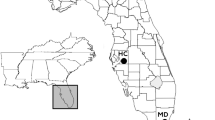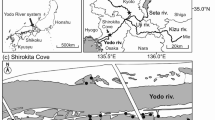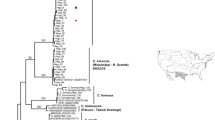Abstract
Human-mediated dispersal has reshaped distribution patterns and biogeographic relationships for many taxa. Long-distance and over-water dispersal were historically rare events for most species, but now human activities can move organisms quickly over long distances to new places. A potential consequence of human-mediated dispersal is the eventual reintroduction of individuals from an invasive population back into their native range; a dimension of biological invasion termed “cryptic back-introduction.” We investigated whether this phenomenon was occurring in the Cayman Islands where brown anole lizards (Anolis sagrei) with red dewlaps (i.e., throat fans), either native to Little Cayman or invasive on Grand Cayman, have been found on Cayman Brac where the native A. sagrei have yellow dewlaps. Our analysis of microsatellite data shows strong population-genetic structure among the three Cayman Islands, but also evidence for non-equilibrium. We found some instances of intermediate multilocus genotypes (possibly 3–9% of individuals), particularly between Grand Cayman and Cayman Brac. Furthermore, analysis of dewlap reflectance data classified six males sampled on Cayman Brac as having red dewlaps similar to lizards from Grand Cayman and Little Cayman. Lastly, one individual from Cayman Brac had an intermediate microsatellite genotype, a red dewlap, and a mtDNA haplotype from Grand Cayman. This mismatch among genetic and phenotypic data strongly suggests that invasive A. sagrei from Grand Cayman are interbreeding with native A. sagrei on Cayman Brac. To our knowledge, this is the first evidence of cryptic back-introduction. Although we demonstrate this phenomenon is occurring in the Cayman Islands, assessing its frequency there and prevalence in other systems may prove difficult due to the need for genetic data in most instances. Cryptic back-introductions may eventually provide some insight into how lineages are changed by the invasion process and may be an underappreciated way in which invasive species impact native biodiversity.




Similar content being viewed by others
References
Bardeleben C, Palchevskiy V, Calsbeek R, Wayne RK (2004) Isolation of polymorphic tetranucleotide microsatellite markers for the brown anole (Anolis sagrei). Mol Ecol Notes 4:176–178
DeCourcy KR, Jenssen TA (1994) Structure and use of male territorial headbob signals by the lizard, Anolis carolinensis. Anim Behav 47:251–262
Earl DA, Vonholdt BM (2012) STRUCTURE HARVESTER: a website and program for visualizing STRUCTURE output and implementing the Evanno method. Conserv Genet Res 4:359–361
Fitzpatrick BM, Shaffer HB (2007) Hybrid vigor between native and introduced salamanders raises new challenges for conservation. Proc Natl Acad Sci 104:15793–15798
Fitzpatrick BM, Johnson JR, Kump DK, Smith JJ, Voss SR, Shaffer HB (2010) Rapid spread of invasive genes into a threatened native species. Proc Natl Acad Sci 107:3606–3610
Gillespie R, Clague D (eds) (2009) Encyclopedia of Islands. University of California Press, Berkelely
Guo Q (2005) Possible cryptic invasion through “back introduction”? Front Ecol Environ 3:470–471
Helmus MR, Mahler DL, Losos JB (2014) Island biogeography of the Anthropocene. Nature 513:543–546
Jombart T, Ahmed I (2012) Adegenet: an R package for the exploratory analysis of genetic and genomic data. http://adegenet.r-forge.r-project.org. R package version 1.3.4
Kearse M, Moir R, Wilson A, Stones-Havas S, Cheung M, Sturrock S, Buxton S, Cooper A, Markowitz S, Duran C, Thierer T, Ashton B, Mentjies P, Drummond A (2012) Geneious Basic: an integrated and extendable desktop software platform for the organization and analysis of sequence data. Bioinformatics 28:1647–1649
Kolbe JJ, Glor RE, Rodriguez-Schettino L, Chamizo-Lara A, Larson A, Losos JB (2004) Genetic variation increases during biological invasion by a Cuban lizard. Nature 431:177–181
Kolbe JJ, Larson A, Losos JB (2007) Differential admixture shapes morphological variation among invasive populations of the lizard Anolis sagrei. Mol Ecol 16:1579–1591
Kolbe JJ, Larson A, Losos JB, de Queiroz K (2008) Admixture determines genetic diversity and population differentiation in the biological invasion of a lizard species. Biol Lett 4:434–437
Kolbe JJ, VanMiddlesworth PS, Losin N, Dappen N, Losos JB (2012) Climatic niche shift predicts thermal trait response in one but not both introductions of the Puerto Rican lizard Anolis cristatellus to Miami, Florida, USA. Ecol Evol 2:1503–1516
Kolbe JJ, Ehrenberger JC, Moniz HA, Angilletta MJ (2014) Physiological variation among invasive populations of the Brown Anole (Anolis sagrei). Physiol Biochem Zool 87:92–104
Liu X, Li X, Liu Z, Tingley R, Kraus F, Guo Z, Li Y (2014) Congener diversity, topographic heterogeneity and human-assisted dispersal predict spread rates of alien herpetofauna at a global scale. Ecol Lett 17:821–829
Losos JB (2009) Lizards in an evolutionary tree: ecology and adaptive radiation of anoles. University of California Press, Berkelely
Losos JB, Schluter D (2000) Analysis of an evolutionary species-area relationship. Nature 408:847–850
MacArthur RH, Wilson EO (1963) An equilibrium theory of insular zoogeography. Evolution 17:373–387
Maia R, Eliason CM, Bitton P-P, Doucet SM, Shawkey MD (2013) pavo: an R package for the analysis, visualization and organization of spectral data. Methods Ecol Evol 4:906–913
McKinney ML, Lockwood JL (1999) Biotic homogenization: a few winners replacing many losers in the next mass extinction. Trends Ecol Evol 14:450–453
Minton SA, Minton MR (1984) Anolis sagrei (brown anole). Herpetol Rev 15:77
Moritz C (1994) Defining ‘evolutionary significant units’ for conservation. Trends Ecol Evol 9:373–375
Peakall R, Smouse PE (2012) GenAlEx 6.5: genetic analysis in Excel. population genetic software for teaching and research—an update. Bioinformatics 28:2537–2539
Posada D, Crandall KA (1998) Modeltest: testing the model of DNA substitution. Bioinformatics 14:817–818
Pritchard JK, Stephens M, Donnelly P (2000) Inference of population structure using multilocus genotype data. Genetics 155:945–959
R Core Team (2014) R: a language and environment for statistical computing. R Foundation for Statistical Computing, Vienna. http://www.R-project.org/
Saltonstall K (2002) Cryptic invasion by a non-native genotype of the common reed, Phragmites australis, into North America. Proc Natl Acad Sci 99:2445–2449
SAS Institute, Inc. (2014) JMP 11.1 Cary, NC
Sax DF, Brown JH, White EP, Gaines SD (2005) The dynamics of species invasions: insights into the mechanisms that limit species diversity. In: Sax DF, Stachowicz JJ, Gaines SD (eds) Species invasion: insights into ecology, evolution, and biogeography. Sinauer Associates, Sunderland, pp. 447–465
Schwartz A, Henderson RW (1991) Amphibians and reptiles of the West Indies: descriptions, distributions, and natural history. University of Florida Press, Gainesville
Scott MP (1984) Agonistic and courtship displays of male Anolis sagrei. Breviora 479:1–22
Searcy CA, Rollins HB, Shaffer HB (2016) Ecological equivalency as a tool for endangered species management. Ecol Appl 26:94–103
Silvestro D, Michalak I (2012) raxmlGUI: a graphical front-end for RAxML. Org Divers Evol 12:335–337
Stamatakis A, Hoover P, Rougemont J (2008) A rapid bootstrap algorithm for the RAxML web servers. Syst Biol 57:758–771
Stuart YE, Campbell TS, Hohenlohe PA, Reynolds RG, Revell LJ, Losos JB (2014) Rapid evolution of a native species following invasion by a congener. Science 346:463–466
Vasquez EA, Glenn EP, Brown JJ, Guntenspergen GR, Nelson SG (2005) Salt tolerance underlies the cryptic invasion of North American salt marshes by an introduced haplotype of the common reed Phragmites australis (Poaceae). Mar Ecol Prog Ser 298:1–8
Williams EE (1969) The ecology of colonization as seen in the zoogeography of anoline lizards on small islands. Q Rev Biol 44:345–389
Wordley C, Slate J, Stapley J (2011) Mining online genomic resources in Anolis carolinensis facilitates rapid and inexpensive development of cross-species microsatellite markers for the Anolis lizard genus. Mol Ecol Resources 11:126–133
Acknowledgements
We thank Haley Moniz, Vikram Chhatre, Brianne Neptin, Melissa Losos, Bonnie Edwards, Thom Sanger, and the Rhode Island Genomics and Sequencing Center staff for assistance. This material is based in part upon work conducted at a Rhode Island NSF EPSCoR research facility, the Genomics and Sequencing Center, supported in part by the National Science Foundation EPSCoR Cooperative Agreement #EPS-1004057. A portion of this project was conducted during the summer Coastal Fellows Program, sponsored by the College of the Environment and Life Sciences at the University of Rhode Island. Permits were graciously provided by Matthew Cottam and the Department of Environment of the Cayman Islands. Funding was provided by a Putnam Expeditionary Grant from the Museum of Comparative Zoology and the University of Rhode Island. We thank Graham Reynolds for providing coalescent dates for A. sagrei and Sozos Michaelides for help with some population genetic analyses.
Author information
Authors and Affiliations
Corresponding author
Electronic supplementary material
Below is the link to the electronic supplementary material.
Rights and permissions
About this article
Cite this article
Kolbe, J.J., Wegener, J.E., Stuart, Y.E. et al. An incipient invasion of brown anole lizards (Anolis sagrei) into their own native range in the Cayman Islands: a case of cryptic back-introduction. Biol Invasions 19, 1989–1998 (2017). https://doi.org/10.1007/s10530-017-1432-2
Received:
Accepted:
Published:
Issue Date:
DOI: https://doi.org/10.1007/s10530-017-1432-2




